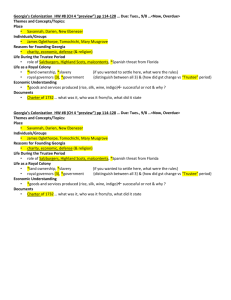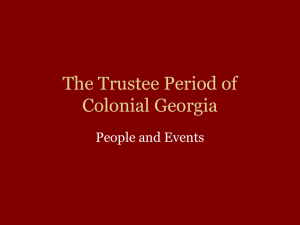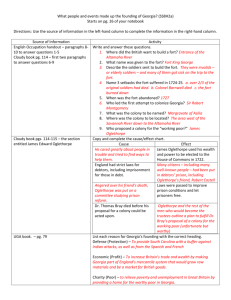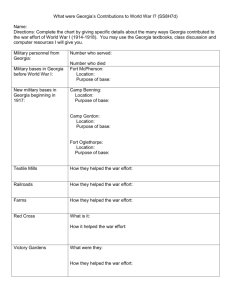SS8H2b TSW analyze the colonial period of Georgia's history. b
advertisement
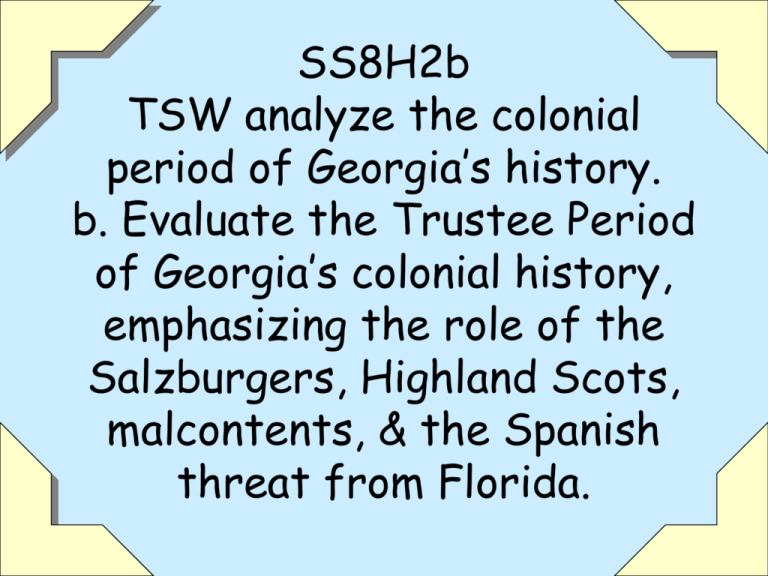
SS8H2b TSW analyze the colonial period of Georgia’s history. b. Evaluate the Trustee Period of Georgia’s colonial history, emphasizing the role of the Salzburgers, Highland Scots, malcontents, & the Spanish threat from Florida. 1 2 The Role of the Salzburgers In March 1734, Oglethorpe was planning to leave for Great Britain to report to the colony’s trustees when new settlers arrived. 3 A group of German Protestants had been forced to leave Salzburg, which was then controlled by Catholics. They were led by John Martin Bolzius and they asked to live in Georgia. 4 Oglethorpe took the Salzburgers to a place 25 miles from Savannah. There they began a town called Ebenezer which means “the Rock of Help.” 5 However, because the land was marshy with poor soil for crops, the Salzburgers asked Oglethorpe for a better site. In 1736, they moved to Red Bluff on the Savannah River. 6 There near Red Bluff they built another town which they called New Ebenezer. 7 Oglethorpe made a trip to Great Britain. When he returned to Savannah in early February 1736, he brought 300 new colonists with him. 8 Included were another group of Salzburgers, some Moravians (Protestants who banded together in Saxony, Germany, 1722) and 2 religious leaders, John and Charles Wesley. 9 Upon his return, Oglethorpe helped the Salzburgers move to Frederica on St. Simons Island. 10 11 James Oglethorpe wanted to protect the Georgia colony from possible attacks from Spanish Florida. The men of Scotland had the reputation of being good soldiers, and so Oglethorpe recruited about 175 of them to settle south of Savannah. 12 The group arrived at the Altamaha River in 1736 and established a settlement they originally called New Inverness. Later they changed the name to Darien. 13 Darien was the only Gaelic [gae-lick] speaking settlement in Georgia. The Highland Scots kept many of their culture's traditions, including the family clans and the wearing of kilts. Left: Darien is located is what is now known as McIntosh County 14 The Highland Scots were hard workers. When they found that the soil was not good for agriculture, they changed to raising cattle and harvesting timber. 15 Their successful economy encouraged other Highland Scots to emigrate to Georgia. 16 In 1739, a number of Darien leaders signed a petition asking that slavery not be introduced into the colony. The was the earliest antislavery petition in the South, and it was successful for a time. The ban against slavery wasn’t lifted until 1749. 17 18 Upon his return from Great Britain in 1736, Oglethorpe introduced several new regulations with the approval of the trustees. 19 Buying rum was to be against the law, and alcohol could not be used in trading with the Native Americans. 20 Slavery was not allowed because Oglethorpe thought it caused landowners to be idle, or inactive, while at the same time, made them want more land. Left: Painting of the Georgia Colony 21 trustees Oglethorpe’s new regulations weren’t popular. The regulations, plus the earlier one about passing on land only to male heirs, began to divide the colonists. 22 They were already facing economic hardships. Their mulberry trees were the wrong kind for producing large amount of silk. They weren’t able to grow hemp, flax, indigo for making blue dye or grapes for wine. 23 To make matters worse, their South Carolina neighbors, who had large amounts of land, slaves, and rum, were doing well. 24 They were growing rice, cotton, and tobacco, and their success was due, in part, to the use of slave labor. Growing numbers of Georgia settlers also wanted slaves. 25 There was less and less support for the trustee’s regulations. Many of the malcontent settlers moved to places where they could live more nearly as they wished. 26 When Oglethorpe returned to Georgia after one of his trips to Great Britain, he found upset people all over the colony. (She doesn’t look very happy, does she?) 27 28 Great Britain controlled Georgia’s borders, and Spain controlled Florida’s. There seemed to be no way to keep the two groups from fighting. 29 In the fall of 1739, a war broke out between Great Britain and Spain. It was called the “War of Jenkins's Ear.” 30 Several years earlier, Spanish sailors were said to have cut off the ear of Robert Jenkins, a British seaman, to serve as a warning to British ship captains smuggling goods off the Florida coast. 31 Oglethorpe welcomed the war. It gave him a good reason to invade neighboring Florida. Left: James Oglethorpe Leads Attack on St. Augustine, 32 1740 A force of about 2,000 men, mostly Native Americans and settlers from Georgia and South Carolina, was quickly organized. They tried to take major Spanish forts in Florida, particularly St. Augustine. map showing British siege of St. Augustine 33 However, a well-organized Spanish militia met Oglethorpe and his soldiers with a surprise attack on June 15, 1740. 34 However, the Spanish won, and Oglethorpe's forces had to retreat to St. Simons Island. 35 During the next two years, there were numerous attacks and counterattacks between the Spanish and British settlers, with neither gaining much ground. 36 In July 1742, Oglethorpe got the opportunity he needed. His forces, assisted by the Highland Scots, waited in the dense woods along the marshes on St. Simons Island. 37 Spanish troops who came that way were caught completely by surprise and forced back across the Florida border. 38 Even though the action was known as the Battle of Bloody Marsh, it was neither big nor bloody. • Left: Reenactment of the Battle of Bloody Marsh 39 This battle did, however, mark the beginning of a safe southern frontier for the British. 40 An Evaluation of the Trustees Period 41 In 1743, Oglethorpe was called to Great Britain to answer charges that he hadn’t acted correctly when he failed to capture the Spanish-held St. Augustine. 42 Oglethorpe was cleared of the charges, but he did not return to Georgia. Instead, he remained in Great Britain. Left: Site of James Oglethorpe's Burial Site (Beneath the Red Carpet at the Front of Parish Church of All Saints, Cranham, England 43 William Stephens, the trustees’ secretary, was named president of a colony filled with disagreement. 44 The effort to keep rum from being sold stopped in 1742. The people still wanted to own more land and to have slaves. 45 By 1750, this was allowed. The regulation against slavery was repealed, along with the one that allowed a colonist to own only 500 hundred acres of land. 46 When President Stephens retired in 1751, he was replaced by his assistant, Henry Parker. President Parker died a year later. 47 Over the next three years (1752-1754), Georgia was led by President Patrick Graham. During his tenure, many settlers who had left under the rule of the trustees returned to the colony. 48 In 1752, one year before the charter’s end, the trustees returned Georgia to King George II. Georgia’s Royal Colony Seal 49 During the 20 years of the original charter, 5,500 people had settled in Georgia. They had built new homes and started new lives. Reverse side of Georgia Royal Seal 50 Although some left the colony to go elsewhere, they still made an imprint of the society and culture. Seal of the Georgia Trustees 51 A large number of settlers were European Protestants who came to the colony to escape religious persecution. In Georgia, they were able to practice their beliefs without fear of punishment. 52 Treaties with American Indians and the elimination of the threat of Spanish invasion ended the need for British military protection. Georgia was a safe haven on the southern frontier. 53 The colony also had noteworthy religious, social, and political accomplishments, Evangelist George Whitfield established the Bethesda Orphans Home in Ebenezer. 54 Later, it was expanded into a school and renamed Bethesda House. The school provided a basic education for many of Georgia’s future leaders. 55 In Savannah, John and Charles Wesley established the first Sunday School in America. They also founded the Methodist Church. John (left) and Charles Wesley 56 The court system, established during the early days of the settlement, still functioned. By 1750, when the colonists gained outright ownership of the land, women were able to inherit property. 57 Perhaps the trustees’ greatest accomplishment was their ability to enable the Georgia colony to survive the many hardships encountered during the first 20 years. The survival set the stage for Georgia to become a successful and profitable royal colony. 58 As we look back on the Georgia colony, it’s important to remember the state motto, Non Sibi Sed Allis which meant “Not for themselves, but for others.” 59
